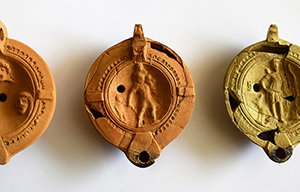Τόμος 3, Τεύχος 1 Ιανουάριος - Απρίλιος 2019
Τενέα
Η ανασκαφή φέρνει στο φως την αρχαία πόλη
Έλενα Κόρκα
Αρχαιολόγος, Διευθύντρια της Έρευνας, Επίτιμη Γενική Διευθύντρια Αρχαιοτήτων και Πολιτιστικής Κληρονομιάς, ΥΠΠΟΑ
Παρασκευή Ευαγγέλογλου, Αρχαιολόγος - Κωνσταντίνος Λαγός, Νομισματολόγος - Χριστίνα Παπαγεωργοπούλου, Ανθρωπολόγος
Δημήτρης Μπάρτζης, Αρχιτέκτων Μηχανικός - Βασιλική Μυλωνά, Συντηρήτρια Αρχαιοτήτων - Μαρία Σύρρου, Νομισματολόγος
 «Ἄν κανείς πάρει ἀπό τόν Ἀκροκόρινθο τόν ὀρεινό δρόμο, συναντᾶ τήν Τενεατική πύλη καί ἕνα ἱερό τῆς Εἰλειθυίας‧ ἡ λεγόμενη Τενέα ἀπέχει ἑξήντα περίπου στάδια». Τόπος προνομιούχος, με εύφορη πεδιάδα και στρατηγική θέση, δεδομένου ότι από αυτήν διερχόταν η συντομότερη οδός που οδηγούσε από την Κόρινθο στις Μυκήνες. Υπήρξε η επιλογή του Αγαμέμνονα «νά ἐγκαταστήσει ἐκεῖ τούς Τρῶες αἰχμαλώτους πού ἔφερε ἀπό τήν Τένεδο». Έκτοτε και καθ’ όλην την αρχαιότητα, αλλά και μέχρι τους βυζαντινούς χρόνους, λειτούργησε ως «πέρασμα». Το 734/33 π.Χ., πολλοί Τενεάτες υπό τον Κορίνθιο αρχηγό Αρχία, αποίκισαν τις Συρακούσες και πολύ αργότερα, κατά την καταστροφή της Κορίνθου από τους Ρωμαίους, η Τενέα υπήρξε η μοναδική πόλη που διασώθηκε και ανεξαρτητοποιήθηκε αποκτώντας δική της διοίκηση, εκμεταλλευόμενη τις θρυλούµενες κοινές ρίζες της µε τους κατακτητές.
«Ἄν κανείς πάρει ἀπό τόν Ἀκροκόρινθο τόν ὀρεινό δρόμο, συναντᾶ τήν Τενεατική πύλη καί ἕνα ἱερό τῆς Εἰλειθυίας‧ ἡ λεγόμενη Τενέα ἀπέχει ἑξήντα περίπου στάδια». Τόπος προνομιούχος, με εύφορη πεδιάδα και στρατηγική θέση, δεδομένου ότι από αυτήν διερχόταν η συντομότερη οδός που οδηγούσε από την Κόρινθο στις Μυκήνες. Υπήρξε η επιλογή του Αγαμέμνονα «νά ἐγκαταστήσει ἐκεῖ τούς Τρῶες αἰχμαλώτους πού ἔφερε ἀπό τήν Τένεδο». Έκτοτε και καθ’ όλην την αρχαιότητα, αλλά και μέχρι τους βυζαντινούς χρόνους, λειτούργησε ως «πέρασμα». Το 734/33 π.Χ., πολλοί Τενεάτες υπό τον Κορίνθιο αρχηγό Αρχία, αποίκισαν τις Συρακούσες και πολύ αργότερα, κατά την καταστροφή της Κορίνθου από τους Ρωμαίους, η Τενέα υπήρξε η μοναδική πόλη που διασώθηκε και ανεξαρτητοποιήθηκε αποκτώντας δική της διοίκηση, εκμεταλλευόμενη τις θρυλούµενες κοινές ρίζες της µε τους κατακτητές.
Λέξεις ευρετηρίου: Αρχαία Τενέα, Χιλιομόδι, Κόρινθος, Τρώες αιχμάλωτοι, Τένεδος, Σαρκοφάγος, Ταφικό Μνημείο
COPYRIGHT: © Θέματα Αρχαιολογίας, 2019 - ISSN 2653-9292
Επικοινωνία με τους συγγραφείς: ekorka@otenet.gr, pevaggeloglou@culture.gr, calagus@yahoo.com, cpapage@he.duth.gr, dbartzis@hotmail.com, vmylona@hotmail.com, maria.syrr12@gmail.com
Το πρωτότυπο άρθρο βρίσκεται στη βιβλιοθήκη του περιοδικού Θέματα Αρχαιολογίας
![]()
Αυτό το άρθρο χορηγείται με άδεια Creative Commons Αναφορά Δημιουργού-Μη Εμπορική Χρήση-Όχι Παράγωγα Έργα 4.0 Διεθνές .
Volume 3, Issue 1 January - April 2019
Tenea
The excavation brings to light the ancient city
Elena KorKa
Archaeologist, Research Director - Honorary Director-General of Antiquities and Cultural Heritage of the Ministry of Culture and Sports, Greece
Paraskevi Evangeloglou, Archaeologist - Konstantinos Lagos, Numismatist
Christina Papageorgopoulou, Anthropologist - Dimitris Bartzis, Architecture Engineer
Vasiliki Mylona, Conservator of Antiquities - Maria Syrrou, Numismatist
 In July 1984, a sarcophagus of the early archaic period was found during rescue excavations in the area of Faneromeni near the town of Chiliomodi. On the interior of the covering slab a unique composition of two lions of monumental character is depicted. The first systematic excavation in the area started in 2013. Initially, a rich archaic cemetery was excavated with unique finds worthy of the importance of the city of Tenea. During the excavations of 2016 and 2017, a magnificent funerary monument of the Roman times was revealed, with a unique lay-out for the Corinthia. Beneath it a cistern was discovered dedicated to ritual purposes. A very rich cemetery surrounds the Roman mausoleum, with burials from the Hellenistic and Roman periods, offering important knowledge in regard to the society, which inhabited the city. In 2018 elaborate domestic complexes were discovered, due to which the excavation of Tenea was considered to be among the most important projects in Greece and abroad.
In July 1984, a sarcophagus of the early archaic period was found during rescue excavations in the area of Faneromeni near the town of Chiliomodi. On the interior of the covering slab a unique composition of two lions of monumental character is depicted. The first systematic excavation in the area started in 2013. Initially, a rich archaic cemetery was excavated with unique finds worthy of the importance of the city of Tenea. During the excavations of 2016 and 2017, a magnificent funerary monument of the Roman times was revealed, with a unique lay-out for the Corinthia. Beneath it a cistern was discovered dedicated to ritual purposes. A very rich cemetery surrounds the Roman mausoleum, with burials from the Hellenistic and Roman periods, offering important knowledge in regard to the society, which inhabited the city. In 2018 elaborate domestic complexes were discovered, due to which the excavation of Tenea was considered to be among the most important projects in Greece and abroad.
Key words: Ancient Tenea, Chiliomodi, Corinth, Tenedos, Trojan prisoners, Sarcophagus, Funerary monument
COPYRIGHT: © Themes in Archaeology, 2019 - ISSN 2653-9292
Authors for correspondence: ekorka@otenet.gr, pevaggeloglou@culture.gr, calagus@yahoo.com, cpapage@he.duth.gr, dbartzis@hotmail.com, vmylona@hotmail.com, maria.syrr12@gmail.com
The original article is in the Library of the Themes in Archeology
![]() Creative Commons Attribution-NonCommercial-NoDerivatives 4.0 International .
Creative Commons Attribution-NonCommercial-NoDerivatives 4.0 International .
Διαβάστε το άρθρο Ανάτυπο PDF
Το πρωτότυπο άρθρο βρίσκεται στη βιβλιοθήκη του περιοδικού Θέματα Αρχαιολογίας
![]() Αυτό το άρθρο χορηγείται με άδεια Creative Commons Αναφορά Δημιουργού-Μη Εμπορική Χρήση-Όχι Παράγωγα Έργα 4.0 Διεθνές .
Αυτό το άρθρο χορηγείται με άδεια Creative Commons Αναφορά Δημιουργού-Μη Εμπορική Χρήση-Όχι Παράγωγα Έργα 4.0 Διεθνές .
